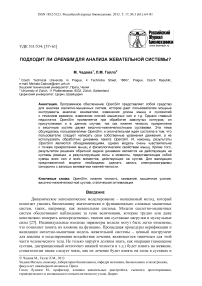Подходит ли OpenSim для анализа жевательной системы?
Автор: Чадова М., Галло Л.М.
Журнал: Российский журнал биомеханики @journal-biomech
Статья в выпуске: 3 (61) т.17, 2013 года.
Бесплатный доступ
Программное обеспечение OpenSim представляет собой средство для анализа скелетно-мышечных систем, которое дает пользователям мощные инструменты анализа: кинематики, изменения длины мышц и сухожилий с течением времени, изменения плечей мышечных сил и т.д. Однако главный недостаток OpenSim проявляется при обработке замкнутых контуров, он присутствовал и в данном случае, так как нижняя челюсть прикреплена к височным костям двумя височно-нижнечелюстными суставами. Эта тема обсуждалась пользователями OpenSim, и окончательная идея состояла в том, что пользователю следует написать свои собственные уравнения движения, а не использовать обработчик динамики пакета OpenSim. И, наконец, результаты OpenSim являются обнадеживающими, однако модель очень чувствительна к точкам прикрепления мышц и физиологическим свойствам мышц. Кроме того, результатом решения обратной задачи динамики являются не действующие на суставы реакции, а результирующие силы и моменты, представляющие собой суммы всех сил и всех моментов, действующих на сустав. Для валидации представленной модели необходимо сделать запись электромиограммы синхронно с записью кинематики нижней челюсти.
Нижняя челюсть, сжимание, мышечное усилие, височно-нижнечелюстной сустав, статическая оптимизация
Короткий адрес: https://sciup.org/146216108
IDR: 146216108 | УДК: 531/534:
Текст научной статьи Подходит ли OpenSim для анализа жевательной системы?
Динамическое математическое моделирование – неоценимый метод, который помогает уяснить биомеханику анатомически и функционально сложных мышечных систем, таких, например, как жевательная система. Модели скелетно-мышечных систем обеспечивают наблюдение за теми величинами, которые трудно или даже невозможно измерить непосредственно, такими как суставные нагрузки и мускульные силы [27]. Индивидуальные входные параметры модели могут быть легко изменены, что позволяет понять их влияние на функцию. Прошедшая процедуры верификации и валидации скелетно-мышечная модель жевательной системы – ценный инструмент для анализа и моделирования воздействия лечения, являющегося типичным для этой части человеческого тела. Не только хирурги должны знать, как операция (замещение сустава, дистракционный остеогенез нижней челюсти и т.д.) будет влиять на жевание, стоматологам также следует знать, как их лечение будет влиять на силы в суставах и
Чадова Михала, инженер, лаборатория биомеханики, кафедра механики, биомеханики и мехатроники, факультет инженерной механики, Прага
Галло Луиджи М., профессор, клиника жевательных расстройств, съемного протезирования, гериатрического и специального стоматологического ухода, Цюрих положение нижней челюсти относительно верхней челюсти. Кроме того, сами исследователи могут извлечь выгоду из таких моделей. Их может интересовать, как нагружен хрящевой диск в височно-нижнечелюстном суставе (ВНЧС). Затем они могут использовать эту информацию в экспериментах по нагружению. Нагрузочные характеристики крайне важны еще и в технологии культивирования тканей организма при выращивании тканей [4, 43].
Среди большого семейства скелетно-мышечных моделей различных частей человеческого тела имеется только несколько математических моделей ВНЧС. Одной из причин этого является то, что ВНЧС рассматривался главным образом как небольшой, не несущий нагрузку и потому не очень важный сустав. Однако влияние больного ВНЧС на отдельных людей и, следовательно, на общество огромно [26, 35]. Другая причина состоит в том, что жевательная система является анатомически и функционально сложной, и поэтому ее трудно моделировать и анализировать [19, 27]. Существуют две основные группы моделей, описывающих движение нижней челюсти и нагружение ВНЧС: 1) модели, в которых структурные элементы считаются абсолютно твердыми [9, 17]; 2) модели, основанные на применении метода конечных элементов (МКЭ) (используется или только МКЭ, или МКЭ в сочетании с абсолютно твердыми структурами [20]). Основными ожидаемыми результатами применения скелетномышечной математической модели жевательной системы являются зависящие от выполненного движения мышечные силы и усилия в суставах. Если используется МКЭ, то представляет интерес и деформация отдельных структурных элементов.
Для моделирования движения и нагружения нижней челюсти и для анализа результирующих усилий в суставах и мышечных сил использовалось различное коммерческое и общедоступное программное обеспечение и различные языки программирования, например: Madymo ( TASS , Рейсвейк, Нидерланды [20]), Adams ( MSC Software Corporation , Калифорния, США [22, 34]), Artisynth ([17, 37]), V-ART и AnyBody ( AnyBody Technology A/S , Ольборг, Дания [9]).
При выборе программного обеспечения для моделирования/анализа жевательной системы следует рассмотреть несколько вопросов, а именно: a ) общедоступным или коммерческим является программное обеспечение? б ) будет ли модель в дальнейшем доступна широкому сообществу исследователей? в ) необходимы ли какие-то навыки программирования или программное обеспечение содержит дружественный графический интерфейс пользователя (ГИП)? г ) является ли модель общепризнанной, готовой для применения любым упомянутым выше программным обеспечением? Уже существующие модели нижней челюсти использовались не только для анализа движения и оценки мышечных усилий, но и как часть более сложных моделей, например для моделирования дыхательных путей (проект OPAL [2]). Однако у всех упомянутых программных продуктов есть некоторые недостатки: или они требуют знания какого-либо языка программирования ( Java, C++, Fortran, Python и т.д.), или в них отсутствует дружественный для пользователя ГИП, или они не являются общедоступными и т.д. Исходя их этого решили воспользоваться программным обеспечением OpenSim , которое никогда прежде не использовалось для анализа таких задач для нижней челюсти, как стискивание, жевание и кусание, но у которого есть многообещающие преимущества, что будет показано позже.
Программное обеспечение OpenSim – это общедоступная среда моделирования, созданная для лучшей интеграции динамических моделей в область науки о движении и для разделения технологий моделирования и самого моделирования [10]. Преимущества OpenSim состоят в том, что оно широко используется для скелетномышечного моделирования (т.е. поддерживаются кинематический и динамический анализ системы, а также оценка мышечных усилий), оно непрерывно развивается и является программным обеспечением свободного доступа. Поэтому в этой среде легче обмениваться моделями, чем при использовании коммерческого программного обеспечения, не являющегося общедоступным.
При загрузке скелетно-мышечной модели в OpenSim становятся доступными несколько инструментов анализа. Прежде всего становится возможным масштабирование с помощью «Инструмента масштабирования». Затем с использованием «Инструмента обратного кинематического анализа» движение, записанное во время эксперимента, связывается с моделью и определяется кинематика в обобщенных координатах. Далее с помощью «Инструмента обратного динамического анализа» вычисляются результирующие силы и вращающие моменты в суставах модели на основе заданного движения, геометрии, внешней нагрузки, массовых и инерционных свойств модели. И наконец, вычисляются мускульные активации/силы с использованием подхода, основанного на статической оптимизации [8, 30, 39, 40]. В работе [13] имеется обзор литературы с необходимой методологической основой. Глубокое понимание математики, используемой на отдельных этапах анализа модели, не является необходимым для успешного применения OpenSim , однако полезно понимать отдельные соотношения в рамках анализа, чтобы быть в состоянии критически интерпретировать результаты.
До настоящего момента модели для анализа актов жевания и сжатия челюстей не строились в OpenSim , поэтому цель данного исследования – представить анализ движения нижней челюсти, оценить усилия жевательных мышц и сделать выводы о преимуществах и недостатках программного обеспечения.
Материалы и методы
Геометрия и определение параметров
По умолчанию OpenSim использует правую систему координат. Наша модель была определена таким образом, что ось X проходила в передне-заднем направлении, ось Y – в краниально-каудальном направлении и ось Z – в медиально-латеральном направлении (рис. 1).
Геометрия черепа, верхней и нижней челюстей, а также точки крепления мышц были взяты из модели, используемой в программном обеспечении Artisynth [14, 37]. Череп и верхняя челюсть были зафиксированы, и только нижняя челюсть могла свободно двигаться.
Для обратного динамического анализа объемные и инерционные ( I ) свойства нижней челюсти были вычислены с использованием программного обеспечения Rhinoceros software ( Robert McNeel & Associates ). Предполагалось, что плотность кости составляет 2100 кг/м3 («плотность идеальной костной ткани с нулевой пористостью» [11]) (см. ниже). Предполагалось, что все кости являются твердыми телами.
Масса ( m ) и осевые моменты инерции ( I ) нижней челюсти:
|
m , кг |
0,12 |
|
I xx , кг∙м2 |
1,48∙10–4 |
|
I yy , кг∙м2 |
1,79∙10–4 |
|
I zz , кг∙м2 |
8,85∙10–5 |
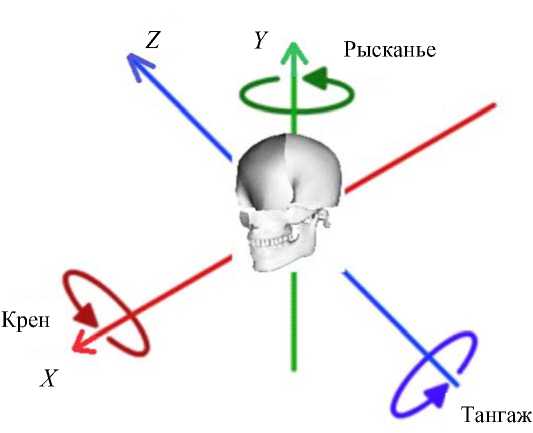
Рис. 1. Правосторонняя система координат в OpenSim . Ось X дорсо-вентральная (положительное направление – вентральное); ось Y каудально-краниальная (положительное направление – краниальное); ось Z медиолатеральная (положительное направление – слева направо по отношению к индивидууму). Обозначения вращений: крен, рысканье, тангаж относительно осей X , Y , Z соответственно
Параметры мышц
Оба ВНЧС имели шесть степеней свободы. Пределы изменения для всех степеней свободы (вращений и трансляций) основывались на литературных данных [5, 15, 23, 28, 42]: тангаж (открывание рта, вращение вокруг медиально-латеральной оси) – 30°; крен (вращение вокруг дорсо-вентральной оси) – ± 3°; рыскание (вращение вокруг кранио-каудальной оси) – ± 3°; боковая экскурсия – ± 9 мм; протрузия – 7 мм; ретрузия – 1,5 мм; опускание – 5 мм.
Для каждой стороны головы пять мышц были разделены на 11 частей: поверхностная жевательная мышца ( m. masseter superficialis ), глубокая жевательная мышца ( m. masseter profundus ), внутренняя крыловидная мышца ( m. pterygoideus medialis ), нижняя наружная крыловидная мышца ( m. pterygoideus lateralis inferior ), верхняя наружная крыловидная мышца ( m. pterygoideus lateralis superior ), передняя височная мышца ( m. temporalis anterior ), средняя височная мышца ( m. temporalis medial ), задняя височная мышца ( m. temporalis posterior ), подбородочно-подъязычная мышца ( m. geniohyoideus ), передняя челюстно-подъязычная мышца ( m. mylohyoideus anterior ) и задняя челюстно-подъязычная мышца ( m. mylohyoideus posterior ) .
Для каждой мышцы на основании литературных данных [36, 41] было определено несколько физиологических свойств: оптимальная и максимальная длина, площадь поперечного сечения, максимальная изометрическая сила и угол перистости (таблица). Кроме того, три соотношения, определяющие величину возникающей силы, были по умолчанию определены в OpenSim (сила в сухожилии – длина сухожилия, активная сила – длина волокна, пассивная сила – длина волокна ). Предполагалось, что мышцы проходят прямолинейно между их точками прикрепления. Для мышц, которые загибаются к суставу или кости, могут быть определены промежуточные точки. Модель Schuttel 1993 Muscle , включенная в OpenSim , использовалась для моделирования мышц [33].
Физиологические свойства жевательных мышц*
|
Мышца |
В я 3 В в св и S Я 5 Я 2 § И Л S н с О |
св И S я св „ ” Я § g s в § в S |
о в: т и ° в § 3 й О о X и |
3 3 я S я S о X о св И S я |
о Г ГМ £ i св О В ° о я С |
cd Щ S НН 8 £ § в 3 « 3 о S и о м св р |
св И s В я я s g с |
с ч |
|
m. maseter superficial |
49,17 |
63,91 |
0,46 |
22,61 |
4,76 |
190,40 |
2,86 |
16.50 |
|
m. maseter profundus |
31,05 |
47,92 |
0,29 |
9,00 |
2,04 |
81,60 |
1,22 |
6,70 |
|
m. pterygoideus medialis |
50,77 |
63,45 |
0,64 |
32,49 |
4,37 |
174,80 |
2,62 |
12.00 |
|
m. pterygoideus lateralis inferior (external pterygoid) |
32,37 |
42,64 |
0,00 |
0,00 |
1,25 |
50,00 |
0,75 |
1.30 |
|
m. pterygoideus lateralis superior (external pterygoid) |
21,10 |
28,72 |
0,00 |
0,00 |
1,25 |
50,00 |
0.75 |
0,00 |
|
m. temporalis anterior |
90,35 |
114,73 |
0,50 |
45,17 |
3,95 |
158,00 |
2,37 |
15,30 |
|
m. temporalis medial |
81,51 |
115,63 |
0,48 |
39,12 |
2,39 |
95,60 |
1,43 |
13,45*** |
|
m. temporalis posterior |
63,80 |
83,63 |
0,51 |
32,53 |
1,89 |
75,60 |
1.13 |
11,60 |
|
m. geniohyoideus |
35,68 |
45,85 |
0,00 |
0,00 |
– |
32,00 |
– |
0,00 |
|
m. mylohyoideus anterior |
29,31 |
37,66 |
0,00 |
0,00 |
– |
35,40 |
– |
0,00 |
|
m. mylohyoideus posterior |
32,97 |
42,36 |
0,00 |
0,00 |
– |
35,40 |
– |
0,00 |
Примечания: * Данные взяты из работы [36]. Отсутствующие данные ( б ) – из работы [41].
** Отношение длины сухожилия к длине волокон мышцы.
*** Значение отсутствует. Взято среднее значение для m. temporalis anterior и m. temporalis posterior .
Динамические данные
Движения черепа и нижней челюсти были записаны оптической системой фиксации движения Optis (клиника нарушений жевательной системы, съемного протезирования, гериатрической стоматологии и стоматологии особого ухода; Цюрихский университет, Швейцария). Триплеты светодиодов были жестко связаны с верхней и нижней зубными дугами (рис. 2, а ). Движение светодиодов было записано тремя высокоскоростными камерами, закрепленными в фиксированную геометрическую конфигурацию (рис. 2, б ). Траектории светодиодов были сохранены на персональном компьютере в .mvm файле (формат бинарного файла). Используя программное обеспечение TmjViewer (зубная клиника; Цюрихский университет,
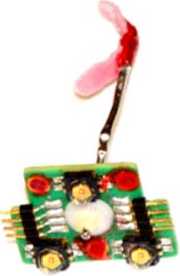
а
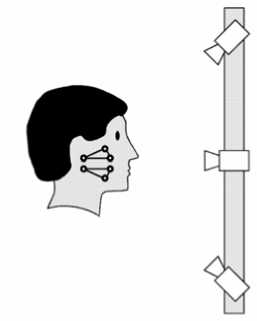
б
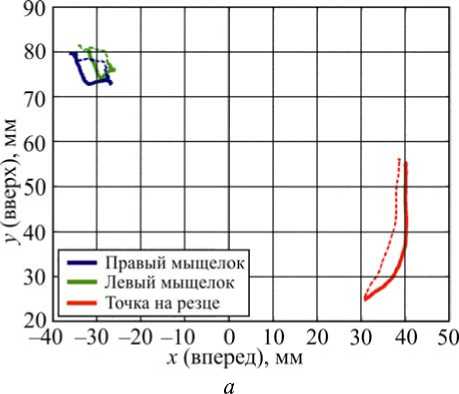
Рис. 3. Движение левого и правого мыщелков и нижней межрезцовой точки: а – движение рассматривалось в сагиттальной плоскости; б – движение рассматривалось с передней стороны. Толстые линии соответствуют первой половине цикла (открывание), тонкие пунктирные линии – второй половине цикла (закрывание). Движение записывалось системой фиксации движения Optis (клиника нарушений жевательной системы; Цюрихский университет, Швейцария). На настоящий момент в модели использовалась только линейная часть траекторий мыщелков
Рис. 2. Детальное изображение одного из триплетов светодиодов на жесткой пластинке, связанной с жестким стержнем изготовленной по заказу шиной ( а ). Отслеживание движения. Два триплета светодиодов жестко связаны с верхней и нижней зубными дугами. Положение светодиодов записывается тремя камерами с фиксированной геометрией расположения ( б ) [21]
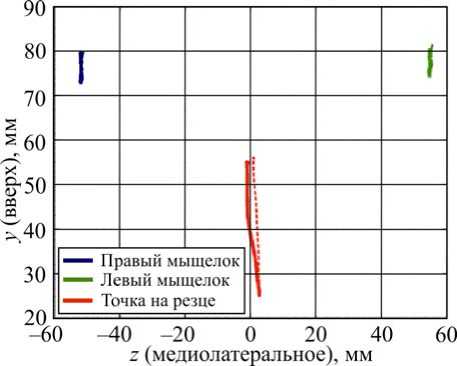
б
Швейцария), траектории светодиодов были преобразованы в траектории левого и правого мыщелков и межрезцовой точки (рис. 3), которые впоследствии использовались в качестве входных кинематических данных для модели в OpenSim (на данный момент в модели использовалась только линейная часть траекторий мыщелков).
Испытуемый и экспериментальный протокол
Для анализа использовались записи, выполненные для одного волонтера. У этого волонтера мужского пола не было особых жевательных проблем. Ему сообщили о цели исследования, и он дал информированное согласие на проведение эксперимента. Во время экспериментальной записи испытуемый сидел прямо,
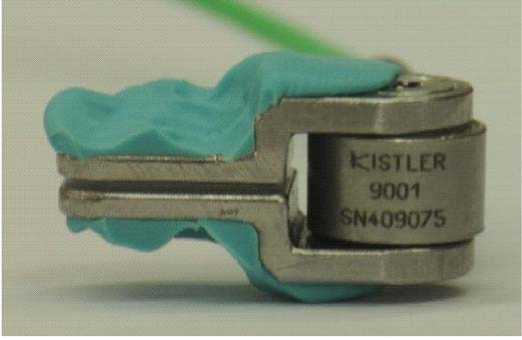
Рис. 4. Одномерный пьезоэлектрический преобразователь силы между двумя металлическими полосами, приспособленными к индивидуальной окклюзии пациента посредством установленных холодной склейкой акриловых полосок на стоматологическом кресле. Презентация в PowerPoint с экспериментальным протоколом прогонялась перед ним на мониторе. Прежде всего испытуемого попросили максимально (в течение 1 с) сжать силовой датчик, помещенный между его левыми первыми премолярами (рис. 4). Затем его попросили максимально открыть рот и медленно закрыть. Весь цикл длился 2,5 с. Светодиоды для записи движения были расположены на правой стороне головы, чтобы избежать пересечения с проводом от силового датчика на левой стороне.
Измерение силы сжатия
Сила сжатия, предшествующего началу открывания рта, была измерена с использованием одномерного пьезоэлектрического преобразователя силы (тип 9001, Kistler AG, CH-8408; Винтертур, Швейцария), закрепленного внецентренно винтами между двумя металлическими полосками, адаптированными к окклюзии испытуемого посредством установленных холодной склейкой акриловых полосок (см. рис. 3). Преобразователь силы был помещен между левыми первыми премолярами. Силовой датчик работал в диапазоне от 0 до 500 Н.
Модель и аналитическая процедура
Недостаток OpenSim , обнаруженный при моделировании, заключается в том, что оно не способно непосредственно моделировать замкнутую кольцевую систему. Последнее означает, что кости связаны таким образом, что они формируют замкнутую кинематическую цепь. Нижняя челюсть, прикрепленная двумя ВНЧС к черепу, является примером такой цепи. В OpenSim при определении сустава говорится, что каждая часть тела присоединяется к материнскому телу только одним суставом. Поэтому, чтобы проверить OpenSim как биомеханический инструмент для анализа жевательной системы, мы начали с модели с одним суставом, т.е. был определен или левый ВНЧС (модель 1А), или правый ВНЧС (модель 1Б). Затем, чтобы получить более реалистические результаты, мы моделировали систему с двумя ВНЧС (модель 2). Для этого нижняя челюсть была разделена на левую и правую части. Каждая часть была присоединена к черепу своим собственным ВНЧС, и было задано ограничение, предотвращающее разъединение обеих частей нижней челюсти.
Аналитическая процедура была следующая. С использованием «Инструмента обратного кинематического анализа» из решения для заданного движения были получены обобщенные координаты сустава(ов). Затем при помощи «Инструмента обратного динамического анализа» и с учетом кинематики, геометрии, внешней нагрузки, массовых и инерционных свойств модели из решения были получены результирующие силы и вращающие моменты в суставе. И наконец, с помощью «Инструмента статической оптимизации» результирующие вращающие моменты использовались в каждый момент времени для вычисления индивидуальных активаций мышц (см. уравнение (1) [3]). При этом мышечные усилия являются побочным результатом решения [13]:
NN
T j = Е F mMT r m , j = E [ a m f ( Fm , l m , v m )] r m , j , (1)
m = 1 m = 1
где N – число мышц в модели; FmMT – сила m -й мышцы (комплекса мышца – сухожилие) на дискретном временном шаге; rm , j – плечо момента m -й мышцы относительно j -й оси сустава; am – уровень активации (безразмерная величина) m -й мышцы на дискретном шаге по времени (1 соответствует максимальной активации, 0 – отсутствию активации); Fm 0 – максимальная изометрическая сила m -й мышцы; lm – длина m -й мышцы; vm – скорость сокращения m -й мышцы; f ( Fm 0 , lm , vm ) – функция сила–длина–скорость m -й мышцы; τ j – обобщенная сила (вращающий момент), действующая относительно j -й оси сустава.
Целевой функцией для оптимизации была сумма квадратов активаций мышц (см. уравнение (2) [3]):
N
J = E ( a m ) 2 . (2)
m = 1
Результаты
Жевательная нагрузка
Максимальная жевательная нагрузка составила 165 Н. Для моделирования были выбрана сила с параболической зависимостью [9] с пиковым значением 165 Н.
Входные кинематические данные
На фазе открывания нижняя межрезцовая точка сместилась на 9 мм дорсально, на 29 мм каудально и на 2,7 мм вправо. На фазе закрывания она переместилась на 1,2 мм влево и вернулась к первоначальному положению (см. рис. 4). Левый мыщелок на фазе открывания переместился на 6,4 мм каудально и 8,2 мм вентрально, тогда как правый мыщелок переместился на 5,9 мм каудально и 5,8 мм вентрально (см. рис. 3). Форма траектории межрезцовой точки согласуется с другими результатами математического моделирования движения нижней челюсти [17] и с записями перемещения зубов (клиника нарушений жевательной системы; Цюрихский университет, Швейцария).
Результирующие силы и вращающие моменты в суставе
Силы в суставе оказались различными для различных моделей. В моделях 1А и 1Б сустав несет всю нагрузку, приложенную к нижней челюсти, тогда как в модели 2 нагрузка должна быть распределена (не обязательно равномерно) между двумя суставами.
Модели только с одним ВНЧС
Модель только с левым ВНЧС
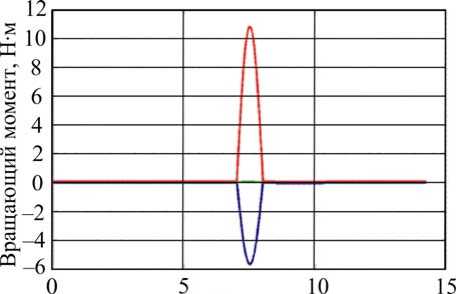
Время, с
Вокруг оси .V (крен) Вокруг оси г (рысканье) Вокруг оси z (тангаж)
Модель только с правым ВНЧС
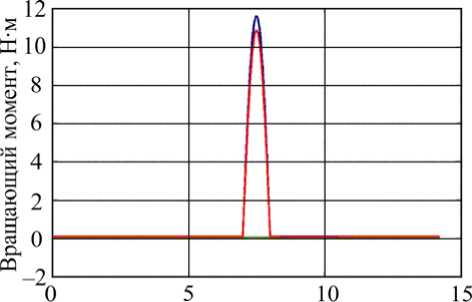
Время, с
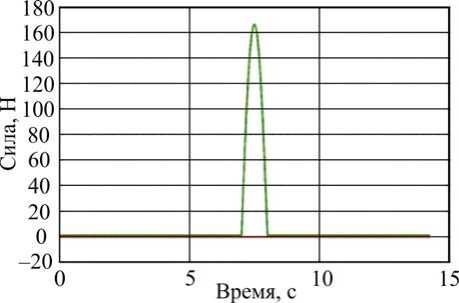
Протрузия/Рструзия (вдоль оси .г) Понижснис/Повышснис (вдоль оси у)
Латеротрузия (вдоль оси z)
Вокруг оси х (крен) Вокруг оси у (рысканье) Вокруг оси z (тангаж)
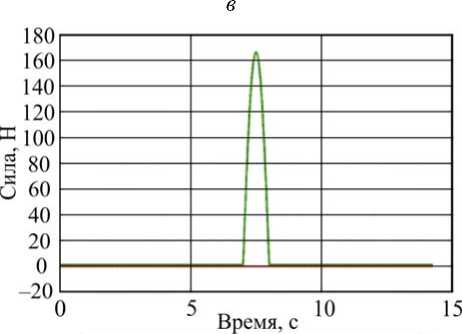
Протрузия/Ретрузия (вдоль оси л) Понижение/Повышение (вдоль оси у) Латеротрузия (вдоль оси z)
б
г
Рис. 5. Результаты обратного динамического анализа для модели с ВНЧС, определенным или на левой стороне ( а , б ), или на правой стороне ( в , г )
Модели 1А и 1Б
В этих моделях нижняя челюсть прикреплена к черепу либо левым, либо правым ВНЧС. На рис. 5 показаны результаты решения обратной динамической задачи, т.е. результирующие вращающие моменты относительно осей x , y и z и результирующие силы в направлении осей x , y и z . На рис. 5, а , б показаны результаты для модели с заданным левым ВНЧС (модель 1А), тогда как на рис. 5, в , г представлены результаты для модели только с правым ВНЧС (модель 1Б).
Модель 2
В этой модели нижняя челюсть была прикреплена к черепу двумя ВНЧС. Здесь силы и вращающие моменты в правом суставе были близки к нулю (внешняя сила действовала между левыми премолярами). В левом суставе вращающие моменты и силы подобны представленным для предыдущей модели (рис. 6).
Модель с двумя ВНЧС
Левый ВНЧС
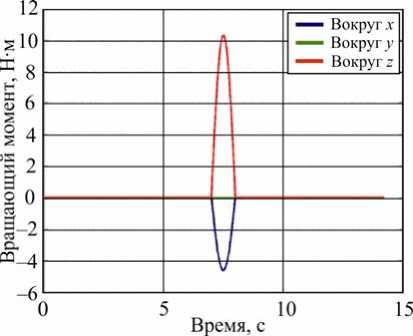
Правый ВНЧС
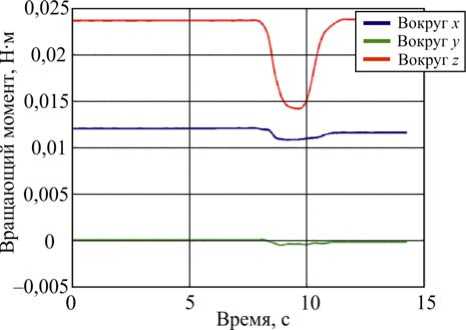
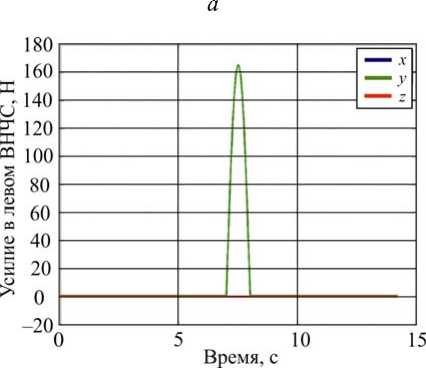
б
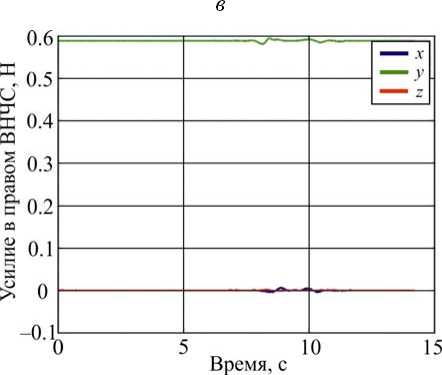
г
Рис. 6. Результаты обратного динамического анализа для модели с двумя ВНЧС: результирующие вращающие моменты ( а ) и результирующие силы ( б ) в левом суставе; результирующие вращающие моменты ( в ) и результирующие силы ( г ) в правом суставе
Активации мышц
Активации мышц, а также мышечные силы были рассчитаны с использованием метода статической оптимизации. Временные тенденции и величины мышечных сил зависят от модели и от предписанных активаций. Активации для выбранных мышц для всех трех моделей представлены на рис. 7.
Обсуждение
Легкость использования программного обеспечения OpenSim
Некоторые преимущества OpenSim были упомянуты во введении (общедоступная среда, широкое использование для скелетно-мышечного моделирования, непрерывное развитие). Новички смогут оценить дружественный ГИП, который может интуитивно использоваться без досконального изучения руководства для пользователя.
Мышца

Модель 1А
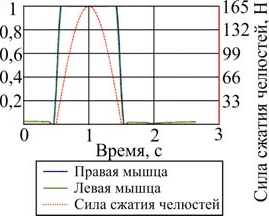
Модель 1Б
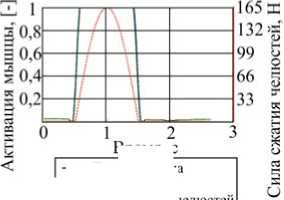
Время, с --- Правая мышца ---Левая мышца
Сила сжатия ч^
Модель 2
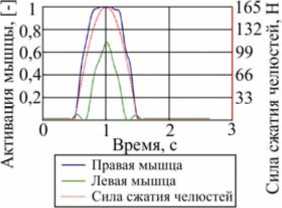
L0.5
165 х
132«
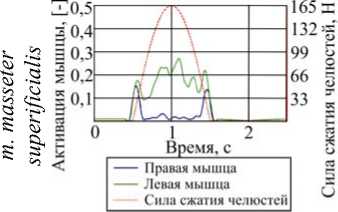
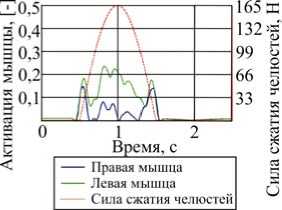
3 0.3
1 0.2
= 0.1
О
О
______ Время, с _______
--- Правая мышца ---Левая мышца Сила сжатия челюстей
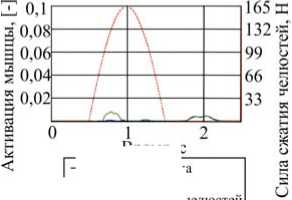
Время, с --- Правая мышца --Левая мышца Сила сжатия ч»
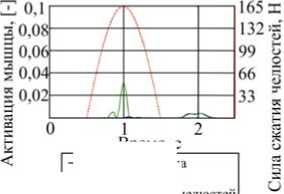
______ Время, с -- Правая мышца ---Левая мышца
Сила сжатия Чч
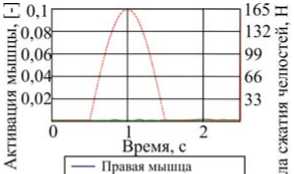
--Левая мышца
Сила сжатия челюстей

Время. С вая мышц ---Левая мышца Сила сжатия ч
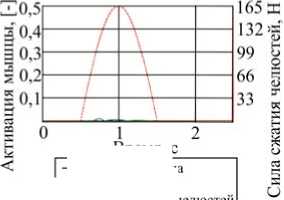
______ Время, с --- Правая мышца ---Левая мышца
Сила сжатия ч«.
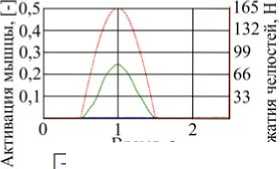
Время. С
--- Правая мышца
--Левая мышца
Сила сжатия челюстей
Рис. 7. Результаты статической оптимизации – активации мышц (безразмерные величины). Изображены результаты для всех трех моделей. Левый столбец: модель 1А (модель с заданным левым ВНЧС), средний столбец: модель 1Б (модель с заданным правым ВНЧС), правый столбец: модель 2 (определены оба ВНЧС). Каждая строка соответствует одной мышце. Термины «левый» и «правый» в обозначениях соответствуют мышцам левой и правой стороны.
Сжатие достигает своего максимума при t = 1 с, фаза открывания – при t = 2 с
Более трудной частью является импортирование кинематики, получаемой с помощью редко встречающейся системы записи движения. В нашем случае при загрузке кинематики из Optis (клиника нарушений жевательной системы; Цюрихский университет, Швейцария) потребовалось написать встроенную программу для конвертации формата наших данных в формат, принятый в OpenSim . В противном случае на интернет-страницах OpenSim доступны комплекты инструментов общего пользования, совместимые с несколькими общеупотребительными системами записи движения (например, C3D , VICON ).
Наиболее трудной частью является интерпретация результатов. Остается неясным, к какой точке (началу системы координат / центру сустава) или к какой системе координат относятся получаемые результаты. На этой стадии пользователь должен быть очень внимательным при считывании выводимых графиков.
Наконец, как подчеркивают разработчики, OpenSim является платформой, на которой сообщество биомехаников может строить библиотеку моделей, которые могут быть использованы для обмена, тестирования, анализа и улучшения через всестороннее сотрудничество. Коммерческие пакеты, такие как SIMM , Visual 3D ( C-Motion Inc. ), Anybody ( Anybody Technology ) или Adams ( MSC Software Corp. ), не обеспечивают полный доступ к исходному тексту программ, что создает помехи исследователям, работающим в области биомеханики, по расширению своих возможностей [10]. Разработчики OpenSim утверждают также, что плагин-технология позволяет развивать среди прочего индивидуализированные регуляторы, аналитические расчеты, контактные модели и модели мышц.
Модель, масштабирование, ограничения
Немасштабированая модель всего тела, по умолчанию генерируемая в OpenSim , основана на индивидууме ростом приблизительно 1,8 м и весом 75,16 кг. Эта сгенерированная модель может быть масштабирована к антропометрическим данным волонтера. Проблемой является точность масштабированной модели по сравнению с моделью, базирующейся, например, на магнитно-резонансной томографии (МРТ).
Данные из литературы по анализу походки показали, что два подхода к моделированию (масштабирование генерируемой модели в сравнении с моделью, основанной на МРТ) дают похожие результаты при расчете мышечных усилий [6, 7], тогда как для плечей моментов и кинематики они дают различные результаты [6, 32]. Что касается возможностей масштабирования в OpenSim , то различные методы масштабирования (однородное масштабирование, неоднородное масштабирование) имели незначительный эффект при определении усилий в тазобедренном суставе ( индивидуальная связь ). Однако Джон Расмуссен ( John Rasmussen ) из группы по разработке программного обеспечения AnyBody рекомендует только неоднородное масштабирование. Все эти результаты объясняют причину, почему так называемые субъектно ориентированные модели почти всегда создаются масштабированием генерируемой модели [12, 24, 32].
У моделей в OpenSim есть и другие ограничения. Даже при том, что есть несколько моделей различных частей тела (рука, голова и шея, нижние конечности и т.д.), они не могут быть просто объединены, чтобы сформировать более сложную модель, например модель всего человеческого тела. Каждая модель нацелена на исследование какой-то конкретной проблемы (анализ кинематики, анализ динамики, статическую оптимизацию и т.д.). И если пользователи забывают об этих ограничениях, то они могут неправильно интерпретировать результаты использования своей модели. Именно поэтому разработчики предлагают использовать более простую, но более детальную модель какой-либо интересующей структуры (мышцы, сустава и т.д.) вместо того, чтобы использовать модель всего тела, но менее детализированную. Наконец, пользователи должны помнить, для чего модель была предназначена и с каким результатом она прошла процесс валидации. Лучший совет, применимый в любой области, звучит так: «Вы должны понимать, что Вы делаете» [31].
Наиболее типичные ошибки начинающих пользователей OpenSim при кинематическом анализе или обратном динамическом анализе состоят в том, что: 1) для отдельных частей тела не задаются массы и моменты инерции; 2) максимальная изометрическая сила, определенная для отдельных мышц, не может удовлетворять тем скоростям и ускорениям, которые соответствуют заданному движению; 3) для некоторых степеней свободы мышцы оказываются незаданными.
Жевательная нагрузка
Измеренная в эксперименте жевательная нагрузка не достигла тех больших значений, о которых сообщается в литературе ((463,51 ± 79,49) Н – нагрузка на премоляры [1], (300 ± 102) Н – нагрузка на первые моляры [34], 441 Н – сила сжатия зубов [9]). Однако она была все же выше величины силы при обычном жевании твердого пищевого комка, например арахиса ((57,7 ± 35,7) Н) [17]. Поскольку жевательные силы зависят от положения и типа силового датчика [16] и также от направления сил, то трудно сопоставлять максимальные значения усилий, достигнутые различными индивидуумами для различных экспериментальных установок.
Обратный динамический анализ – результирующие силы и вращающие моменты в суставе
Первым различием между двумя моделями является результат, следующий из обратного динамического анализа, т.е. результирующие силы и вращающие моменты в обоих ВНЧС (см. рис. 5, 6):
-
1. В модели 1, независимо от того, левый или правый сустав задается, результаты оказываются подобными (см. рис. 5). Только положение приложенной внешней силы (силы сжатия, действующей на преобразователь силы), а также положение сустава совместно влияли на величину вращающего момента вокруг медиолатеральной оси. Следует напомнить, что для моделей 1А и 1Б вращающие моменты и силы независимы друг от друга. В обоих случаях мы имеем геометрические характеристики для системы с одним суставом, и результаты, полученные для этих моделей, не могут быть объединены и представлены как результат одной модели с левым и правым суставами.
-
2. В противоположность модели 1 в модели 2 оба сустава влияют друг на друга. Для этой модели силы и вращающие моменты в левом суставе подобны тем, что получены в предыдущей модели только с левым суставом (см. рис. 6). Результирующие силы и вращающие моменты в правом суставе близки к нулю.
Общепринято, что реакция в суставе на балансирующей стороне выше, чем в суставе на рабочей стороне [9, 17, 38]. Были опубликованы данные, согласно которым соотношение реакций в суставах на балансирующей и рабочей сторонах лежит в интервале между 1 и 1,5 [17, 18]. Как видно из рис. 6, результаты OpenSim (модель 2) не подтверждают эти сведения. Однако результатами обратного динамического анализа в OpenSim являются «результирующие силы и вращающие моменты», т.е. суммы всех сил и всех вращающих моментов, действующих на сустав, а не реакции в суставе.
Статическая оптимизация – активации мышц и мышечные усилия
Различие между этими тремя моделями, касающееся активаций мышц и, следовательно, мышечных сил, имеет место из-за различий в этих моделях определения сустава(ов) и взаимоотношения между положением(ями) сустава(ов) и приложенной силой. Модели 1А и 1Б дают похожие результаты, которые слегка отличаются от результатов модели 2.
Модель 1
Активации мышц в модели 1A изменялись от нуля, означающего, что активация вообще отсутствует, (например, для pterygoideus lateralis superior ), через очень маленькие активации (< 0,05), (например, для masseter profundus, geniohyoideus, temporalis anterior (левая)), до максимально активированных мышц, таких как temporalis posterior (во время фазы стискивания зубов). Для модели 1Б была подобная ситуация. Активации мышц колебались от нуля (для masseter profundus и pterygoideus lateralis superior ) до максимально активированной temporalis posterior (во время фазы стискивания зубов).
Вообще мышечные силы на левой стороне были выше, чем аналогичные силы на правой стороне, как и ожидалось для нагрузки, действующей между первыми левыми премолярами.
Модель только с одним определенным суставом (без разницы – левым или правым) является все же чрезмерным упрощением реальной ситуации и потому не должна использоваться для скелетно-мышечного анализа движения нижней челюсти и расчета жевательных мышц.
Модель 2
При оценке активации мышц и мышечных сил для заданной кинематики первой вещью, нуждающейся в проверке, являются периоды времени активации мышц, а затем соотношение между максимальной мышечной активацией/силой и внешней приложенной нагрузкой.
В период сжатия (поднимания нижней челюсти, т.е. между 0,5 и 1,5 с с максимальным сжатием при t = 1 с анализируемого цикла) активация ожидается для следующих мышц: temporalis , средняя pterygoideus и masseter . При открывании рта между 1,5 и 2 с активация ожидается для мышц geniohyoideus, mylohyoideus и pterygoideus lateralis . Для фазы закрывания (2–2,5 с) ожидается активация тех же самых мышц, что и при сжатии (хотя и с много меньшей активацией/силой).
Во время фазы сжатия согласно нашим результатам наиболее активными мышцами являются superficial masseter (максимальная активация обеих, левой и правой, была меньше 0,2), pterygoid lateralis inferior левая (максимальная активация 0,22), temporalis medial (левая мышца достигала активации 1, а правая не более 0,2), temporalis posterior (правая мышца достигала активации 1, а левая 0,7) и mylohyoideus posterior (максимальная активация достигала 1). За исключением мышц lateral pterygoid (inferior) и posterior mylohyoid произошли активации тех мышц, которые и предполагались. Кроме выдвижения нижней челюсти вперед и ее опускания функцией мышцы lateral pterygoid является также общая стабилизация мыщелка, которая может оправдать активацию этой мышцы во время фазы сжатия. Однако функция мышцы mylohyoid – опускание нижней челюсти, поэтому эта мышца должна быть активной только во время фазы открывания рта (она также поднимает кость hyoid , но этот процесс мы не моделировали и поэтому не обсуждаем). Факт активации можно было бы объяснить точками прикрепления мышцы (однако они всякий раз брались из литературы). В нашей модели линия действия mylohyoideus posterior проходит почти медиолатерально и место прикрепления мышцы расположено в самой задней части челюстно-подъязычной линии на внутренней части нижней челюсти. Поскольку в OpenSim навязано отсутствие контакта между ямкой и мыщелком нижней челюсти, задняя часть челюстно-подъязычной мышцы вместе с мышцей, поднимающей нижнюю челюсть, может управлять положением мыщелка нижней челюсти, чья кинематика должна быть удовлетворена при моделировании.
Мышцы, которые были активны во время фазы открывания рта, – digastricus (активна только в начале открывания: активация левой мышцы менее 0,1; активация правой мышцы менее 0,01), mylohyoideus anterior (максимальная активация обеих, левой и правой, менее 0,1), geniohyoideus (максимальная активация обеих, левой и правой, менее 0,01). Активация этих мышц находится в этой ожидаемой фазе. Активация постоянно увеличивается, пока не будет достигнуто положение максимально открытого рта, а затем активация уменьшается. Даже при том, что активации мышц довольно малы, гравитационная сила также помогает опусканию нижней челюсти, и потому большие значения сил/активаций мышц-опускателей нижней челюсти не нужны.
Вместе с уменьшением активации опускателей нижней челюсти в фазе закрывания рта увеличивается активация мышц, поднимающих нижнюю челюсть. Однако их активация не превышают величины 0,004. Это может иметь место из-за медленного движения нижней челюсти и из-за малого диапазона движения нижней челюсти в представленном исследовании.
Другой причиной минимальной активации нескольких мышц может быть выбранная для оптимизации целевая функция. OpenSim поддерживает только один тип оптимизируемой функции в форме
N
J = £ a' . • (3) m = 1
где N – число мышц; p – константа, определяемая пользователем. На основе работы [29] была выбрана сумма квадратов мышечных сил ( p = 2) (см. уравнение (2)). Вследствие того, что, как упомянуто в [25], «универсальный общепринятый критерий для отбора задействованных мышц не был установлен», пользователь сам решает, какой критерий применять. Как отмечалось в работе [39], при статической оптимизации жевательных мышц совместно с неизвестными суставными силами лучше всего в качестве целевой функции минимизировать нагрузку на сустав, что предопределяет базовую роль сустава. Однако в OpenSim нет возможности использовать такую целевую функцию. Кроме того, в статье [25] отмечено, что минимизация нагрузки на сустав приводит к подобному же набору задействованных мышц, как минимизируемая целевая функция, представляющая собой сумму квадратов напряжений в мышцах.
Другая проблема заключается в оценке того, являются ли достигнутые за цикл значения мышечных сил правильными. Эйб ( Abe ) [1] опубликовал соотношения между мышечными силами и жевательной нагрузкой для masseter и temporalis , которые равны 1,35 и 0,65 соответственно (нагружаются премоляры, активная сторона). Наши результаты дают соотношения 0,18 и 0,5 для поверхностного masseter и среднего temporalis . При максимальной изометрической силе средней височной мышцы сила могла теоретически достигнуть 95 Н, что дало бы нам отношение мышечная сила / жевательная нагрузка, равное 0,57. Это, однако, все же меньше, чем дает Эйб. Подобное характерно для поверхностной жевательной мышцы, для которой соотношение в нашем случае можно было бы увеличить до 1,15 (предполагается, что максимальная изометрическая сила для masseter составляет 190 Н). На основании этих результатов приходим к заключению, что мышечные силы, основанные на заложенной в OpenSim оптимизации, имеют тенденцию при удовлетворении силы сжатия быть намного меньшими по сравнению с приведенными Эйбом.
Другая возможность проверки получающихся в результате мышечных сил состоит в их сравнении с диаграммами электромиографических (ЭМГ) измерений, как это сделал де Зее (de Zee) [9]. Однако не для всех мышц, используемых в модели, мышечная активность может быть измерена неинвазивно. При измерении мышечной активности маленьких мышц или медиально расположенных мышц использование при ЭМГ иглы может стать стимулирующим. Кроме того синхронизация между ЭМГ-сигналом и кинематическими данными должна быть очень точной. Наконец, ЭМГ-сигнал не прямо пропорционален мышечным силам. Поэтому следует тщательно подбирать подходящий ЭМГ-анализ.
Заключение
Представленное исследование было нацелено на решение вопроса, подходит ли общедоступное программное обеспечение OpenSim для анализа жевательной системы.
Оказалось, что OpenSim – это мощный биомеханический инструмент, легкий в использовании. Однако он иногда работает как «черный ящик», и пользователь может быть озадачен полученными результатами. Есть также один серьезный недостаток его использования для анализа жевательной системы, проявляющийся при обработке замкнутых контуров. Эта тема обсуждалась пользователями OpenSim , и окончательная идея состояла в том, что пользователю следует написать свои собственные уравнения движения, а не использовать обработчик динамики пакета OpenSim .
Однако инструменты кинематического анализа в OpenSim дают нам мощные средства как для анализа кинематики (линейных и угловых скоростей и ускорений), так и изменения длины мышц и сухожилий с течением времени, а также плеч мускульных сил по отношению к суставу и т.д. Эти средства могут быть использованы в качестве входной информации в записанных пользователем уравнениях движения и в его собственной процедуре статической оптимизации. По-видимому, такая процедура (комбинирование OpenSim и, например, MatlabTM ) является многообещающим инструментом обработки сложного движения нижней челюсти.
В представленном исследовании мы моделировали нижнюю челюсть, используя два разных подхода: 1) нижняя челюсть была связана с черепом только одним суставом; 2) при моделировании учитывались оба ВНЧС. Модель только с одним суставом, по существу, является чрезмерным упрощением реальной анатомии и потому дает только приблизительные результаты. Результаты второй модели являются более перспективными, однако модель очень чувствительна к точкам прикрепления мышц и физиологическим свойствам мышц, поэтому следует заботиться об их непротиворечивости. Кроме того, результаты, полученные в OpenSim в задаче обратной динамики (силы в суставе), отличались от ожидаемых. Однако этими результатами являются «результирующие силы и вращающие моменты», которые представляют собой суммы всех сил и всех вращающих моментов, действующих на сустав, а не реактивные силы. Этим можно объяснить отличия в результатах.
Для валидации представленной модели необходимо синхронно с записью кинематики нижней челюсти сделать запись ЭМГ.
Благодарности
Эта работа была поддержана программой непрерывного образования «Эразмус», агентством по грантам Чешского технического университета в Праге (Чешская Республика), грант № GS10/247/OHK2/3T/12, и базовым финансовым планом Цюрихского университета (Швейцария).
Список литературы Подходит ли OpenSim для анализа жевательной системы?
- Abe M. Temporomandibular joint loading generated during bilateral static bites at molars and premolars//Medical & Biological Engineering & Computing. -2006. -Vol. 44, No. 11. -P. 1017-1030.
- Abugharbieh R. OPAL Project, 2012. -URL: http://www.magic.ubc.ca/artisynth/pmwiki.php?n=OPAL. HomePage.
- Anderson F., Guendelman E., Habib A., Hamner S., Holzbaur K., John C., Ku J., Liu M., Loan P., Reinbolt J., Seth A., Delp S. OpenSim User's Guide, 2.01 edition, 2010. -URL: https://simtk.org/home/opensim.
- Athanasiou K.A. Tissue engineering of temporomandibular joint cartilage//Tissue Engineering of the Disc. -2009. -P. 45-56.
- Celic R., Jerolimov V., Knezovic Zlataric D. Relationship of slightly limited mandibular movements to temporomandibular disorders//Brazilian Dental Journal. -2004. -Vol. 15, No. 2. -P. 151-154.
- Correa T.A. Accuracy of generic musculoskeletal models in predicting the functional roles of muscles in human gait//Journal of Biomechanics. -2011. -Vol. 44, No. 11. -P. 2096-2105.
- Correa T.A., Pandy M.G. A mass-length scaling law for modeling muscle strength in the lower limb//Journal of Biomechanics. -2011. -Vol. 44, No. 16. -P. 2782-2789.
- Crowninshield R.D., Brand R.A. A physiologically based criterion of muscle force prediction in locomotion//Journal of Biomechanics. -1981. -Vol. 14, No. 11. -P. 793-801.
- De Zee M. Validation of a musculo-skeletal model of the mandible and its application to mandibular distraction osteogenesis//Journal of Biomechanics. -2007. -Vol. 40, No. 6. -P. 1192-1201.
- Delp S.L. OpenSim: open-source software to create and analyze dynamic simulations of movement//IEEE Transactions on Bio-Medical Engineering. -2007. -Vol. 54, No. 11. -P. 1940-1950.
- Doblare M., Garcia J.M. Anisotropic bone remodelling model based on a continuum damage-repair theory//Journal of Biomechanics. -2002. -Vol. 35, No. 1. -P. 1-17.
- Donati M. Enhanced anatomical calibration in human movement analysis//Gait & Posture. -2007. -Vol. 26, No. 2. -P. 179-185.
- Erdemir A. Model-based estimation of muscle forces exerted during movements//Clinical Biomechanics. -2007. -Vol. 22, No. 2. -P. 131-154.
- Fels S. ArtiSynth: A Biomechanical Simulation Platform for the Vocal Tract and Upper Airway, 2006.
- Gallo L.M., Brasi M., Ernst B., Palla S. Relevance of mandibular helical axis analysis in functional and dysfunctional temporomandibular joints//Journal of Biomechanics. -2006. -Vol. 39, No. 9. -P. 1716-1725.
- Gonzalez Y. Reliability of electromyographic activity vs. bite-force from human masticatory muscles//European Journal of Oral Sciences. -2011. -Vol. 119, No. 3. -P. 219-224.
- Hannam A.G. A dynamic model of jaw and hyoid biomechanics during chewing//Journal of Biomechanics. -2008. -Vol. 41, No. 5. -P. 1069-1076.
- Iwasaki L.R. Temporomandibular joint loads in subjects with and without disc displacement//Orthopedic Reviews. -2009. -Vol. 1, No. 2. -P. 90-93.
- Koolstra J.H. Dynamics of the human masticatory system//Critical Reviews in Oral Biology and Medicine: An Official Publication of the American Association of Oral Biologists. -2002. -Vol. 13, No. 4. -P. 366-376.
- Koolstra J.H., Van Eijden T.M. Combined finite-element and rigid-body analysis of human jaw joint dynamics//Journal of Biomechanics. -2005. -Vol. 38, No. 12. -P. 2431-2439.
- Krebs M. Dynamic stereometry of the temporomandibular joint from 3d imaging and tracking data: abstract of Ph.D. thesis. -Swiss Federal Institution of Technology, 1997.
- Langenbach G.E., Hannam A.G. The role of passive muscle tensions in a three-dimensional dynamic model of the human jaw//Archives of Oral Biology. -1999. -Vol. 44, No. 7. -P. 557-573.
- Lemoine J.J. Radiographic analysis for jaw motion normalization//Journal of Oral and Maxillofacial Surgery: Official Journal of the American Association of Oral and Maxillofacial Surgeons. -2005. -Vol. 63, No. 7. -P. 961-967.
- Lu T.W., O'connor J.J. Bone position estimation from skin marker co-ordinates using global optimisation with joint constraints//Journal of Biomechanics. -1999. -Vol. 32, No. 2. -P. 129-134.
- May B., Saha S., Saltzman M. A three-dimensional mathematical model of temporomandibular joint loading//Clinical Biomechanics (Bristol, Avon). -2001. -Vol. 16, No. 6. -P. 489-495.
- Nickel J.C. Static and dynamic mechanics of the temporomandibular joint: plowing forces, joint load and tissue stress//Orthodontics & Craniofacial Research. -2009. -Vol. 12, No. 3. -P. 159-167.
- Peck C.C., Hannam A.G. Human jaw and muscle modelling//Archives of Oral Biology. -2007. -Vol. 52, No. 4. -P. 300-304.
- Peck Ch.C. Dynamic musculoskeletal biomechanics in the human jaw: abstract of Ph.D. thesis. -The University of British Columbia, Department of Oral Biology, 1999.
- Pedotti A., Krishnan V.V., Stark L. Optimization of muscle-force sequencing in human locomotion//Mathematical Biosciences. -1978. -Vol. 38, No. 1-2. -P. 57-76.
- Prilutsky B.I., Zatsiorsky V.M. Optimization-based models of muscle coordination//Exercise and Sport Sciences Reviews. -2002. -Vol. 30, No. 1. -P. 32-38.
- Rasmussen J. “As simple as possible …”. Biomechanics For Everybody: A personal view on biomechanics and its fascinating applications. -URL: http://biomechanicsforeverybody.wordpress.com/2013/02/04/as-simple-as-possible.
- Scheys L. Calculating gait kinematics using MR-based kinematic models//Gait & Posture. -2011. -Vol. 33, No. 2. -P. 158-164.
- Schutte L.M. Improving the efficacy of electrical stimulation-induced leg cycle ergometry: an analysis based on a dynamic musculoskeletal model//IEEE Transactions on Rehabilitation Engineering. -1993. -Vol. 1, No. 2. -P. 109-125.
- Sellers W.I., Crompton R.H. Using sensitivity analysis to validate the predictions of a biomechanical model of bite forces//Annals of Anatomy -Anatomischer Anzeiger: Official Organ of the Anatomische Gesellschaft. -2004. -Vol. 186, No. 1. -P. 89-95.
- Spilker R.L., Nickel J.C., Iwasaki L.R. A biphasic finite element model of in vitro plowing tests of the temporomandibular joint disc//Annals of Biomedical Engineering. -2009. -Vol. 37, No. 6. -P. 1152-1164.
- Stavness I.K. Dynamic modeling of human jaw and laryngeal biomechanics: abstract of master thesis. -The University of British Columbia, Faculty of Graduate Studies, 2006.
- Stavness I., Hannam A.G., Loyd J.E., Fels S. An integrated, dynamic jaw and laryngeal model constructed from CT data//Proceedings of ISBMS-2006, 10-11 July 2006. -Zurich, 2006. -P. 169-177.
- Throckmorton G.S., Groshan G.J., Boyd S.B. Muscle activity patterns and control of temporomandibular joint loads//The Journal of Prosthetic Dentistry. -1990. -Vol. 63, No. 6. -P. 685-695.
- Trainor P.G., Mclachlan K.R., McCall W.D. Modelling of forces in the human masticatory system with optimization of the angulations of the joint loads//Journal of Biomechanics. -1995. -Vol. 28, No. 7. -P. 829-843.
- Tsirakos D., Baltzopoulos V., Bartlett R. Inverse optimization: functional and physiological considerations related to the force-sharing problem//Critical Reviews in Biomedical Engineering. -1997. -Vol. 25, No. 4-5. -P. 371-407.
- Van Eijden T.M., Korfage J.A., Brugman P. Architecture of the human jaw-closing and jaw-opening muscles//The Anatomical Record. -1997. -Vol. 248, No. 3. -P. 464-474.
- Villamil M.B. Simulation of the human temporomandibular joint behavior based on interdependent joints topology//Computer Methods and Programs in Biomedicine. -2012. -Vol. 105, No. 3. -P. 217-232.
- Waldman S.D. Effect of biomechanical conditioning on cartilaginous tissue formation in vitro//The Journal of Bone and Joint Surgery. American Volume. -2003. -Vol. 85-A, Suppl. 2. -P. 101-105.

